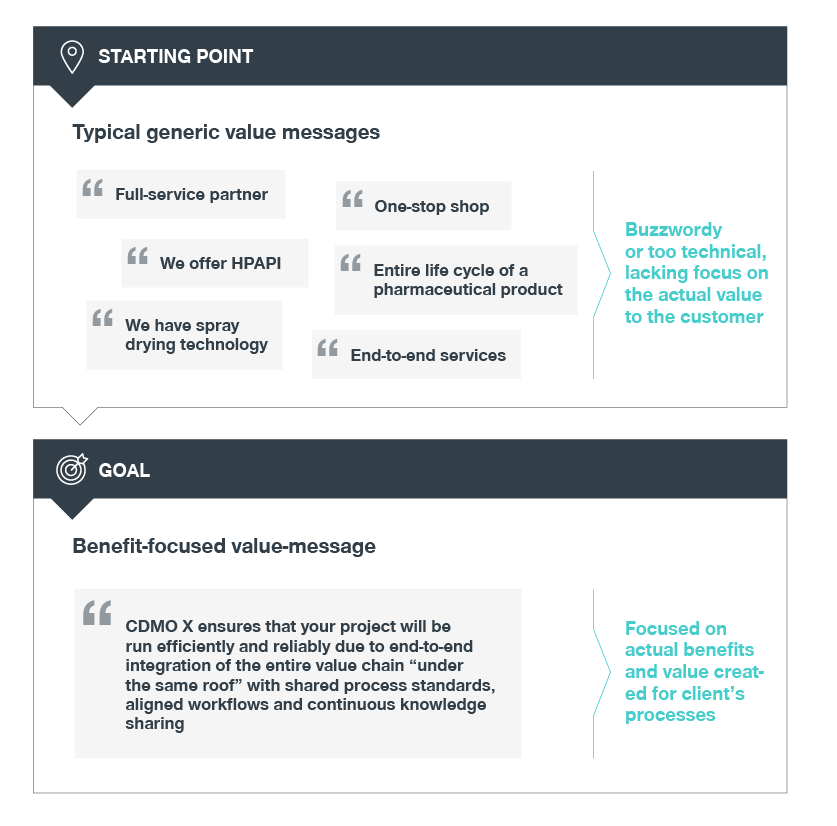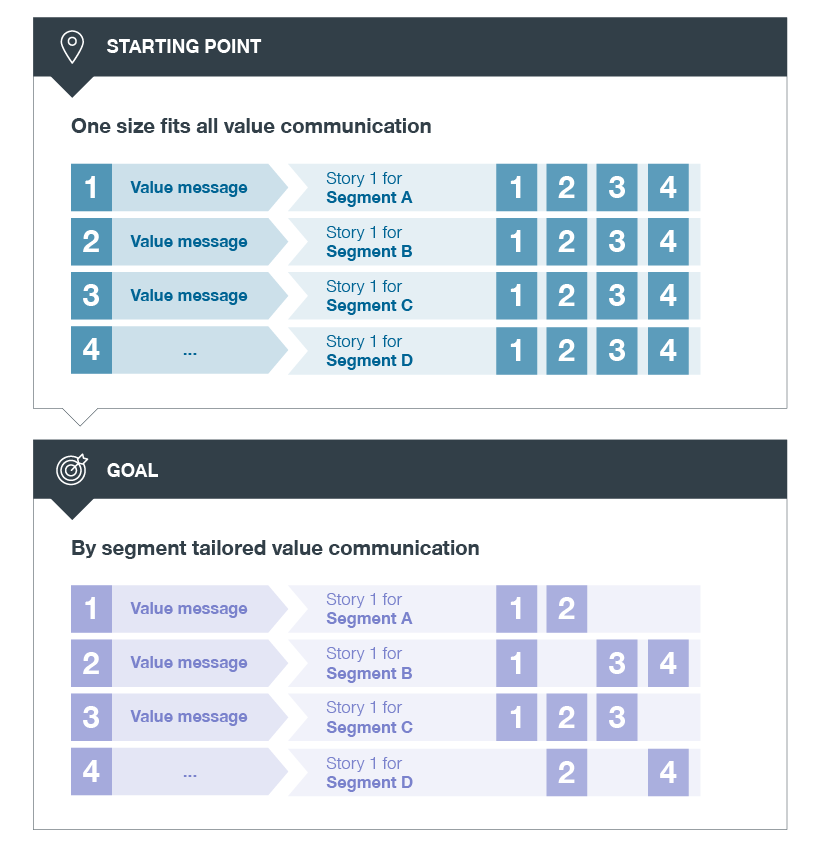Quoting is a critical process for CDMOs. It brings together different components, including offering and pricing, into one central and aligned format and sets the expectations for the project. However, our experience shows that CDMO quoting is often cumbersome, time-consuming, and technical-focused and lacks standardization and benefit-driven communication. In the final part of this series, we provide a better way for quoting and value communication.
As outlined in our series introduction, the CDMO market has been on an upward trajectory, offering significant growth prospects. However, CDMOs must navigate several commercial challenges to fully seize these opportunities.
One of these challenges, in addition to better offering and better pricing, is the quoting trap: The way CDMOs articulate their services in quotes is oftentimes too technical and standardized instead of benefit-driven and customized. This often leads to clients not understanding the full extent of an offer or the value provided. In the current environment, where more and more pharma companies have professional procurement teams, benefit-driven communication becomes even more relevant. By shifting the focus from technical details to clearly articulating the benefits of services, CDMOs ensure that clients fully understand the value offered, differentiating themselves in the competitive market.
But reality looks different.
Even when a client and project are won, the scope and contract often leave room for interpretation. CDMOs work with clients on complex projects that involve multiple stages and require a range of different services. If the scope of the project is not clearly defined or agreed on by both parties, it can lead to misunderstandings, disagreements, and delays. Resources and efforts are wasted, and potential is missed by clients who could have benefited from additional services – but didn’t know they existed.
As outlined in the offering article, unstructured offerings can lead to extensions in the proposal turnaround time. However, there are further challenges that lead to process inefficiencies, for example, involving many different stakeholders, process steps not being clear or integrated well, roles and responsibilities being interpreted differently, and a lot of manual work involved in collecting input and adjusting the proposal for each client. In the end, clients are left with an encrypted proposal that takes a long time to be developed and doesn’t communicate the actual value for them.
The good news? Although the services provided by CDMOs are complex and highly technical by default, the quotation process and value story shared with clients don’t have to be limited to that.
To fully capitalize on the potential for growth in the CDMO market, it’s essential to successfully navigate the quoting process. This requires moving away from the current cumbersome processes and feature-based communication toward a structured and tool-supported process combined with benefit-driven communication.
Interested in learning more about why effective communication and better quoting is essential for you as a CDMO? Read the following blog for more information on achieving customer satisfaction, positioning yourself for long-term success, and driving profitable growth.
Why improving your current quoting is relevant
Better quoting and communication can benefit you in various ways. Firstly, it can save time and improve proposal turnaround times by increasing efficiency and reducing internal alignments. Additionally, it can improve alignment with client expectations, leading to reduced proposal revisions, minimized scope creep, and higher customer satisfaction. Consequently, you’ll be able to increase the win rate while reducing the effort required to finalize the quotes.
You can further increase the relevance and success of your quote via clear value communication, ensuring consistent, high-impact messaging and benefit communication and addressing clients’ most relevant pain points.
Lastly, including value-driven client assessment criteria early on in proposal processes enables you to quickly identify the opportunities that deserve a lot of time investment from the team and fill your capacities with attractive clients and projects.
What does a better quoting look like?
All in all, better value communication and quoting setup can help you truly wrap the offer and pricing together. But what distinguishes such a setup? The following three attributes are key:
Tailored: Knowing clients’ pain points and addressing them clearly with a benefit-driven value story
Precise: Outlining the proposed offering and T&Cs with a sufficient level of detail to ensure clarity and avoid potential misunderstandings with regard to SOW changes or breach of contract
Pragmatic: Having standardized, automated, and efficient processes that enable a short proposal turnaround time
Standardize and optimize quotes today
To get a better quoting in place, there are four key steps you should follow:
1. Create value messages that specifically address clients’ pain points and needs
Are your value messages generic with a focus on technical details? Then you are likely failing to address client pain points and highlight the benefits you deliver to clients.

Best practice: Develop clear and concise value messages that effectively communicate the benefits of your services and highlight key pain points from a client perspective. Package this in straightforward language that clients can easily understand.
If technical information is necessary, frame it in a way that highlights the value for the client. For example, focus on shared processes, same quality standards, aligned workflows, and continuous knowledge sharing if you decide to emphasize your end-to-end services.
Clearly articulating benefits and highlighting value help you achieve your deserved price premium over the competition. This helps shed light on your capabilities and establishes fact-based confidence in pricing negotiations, creating a shared value perception among all relevant stakeholders.
2. Adapt value communication to client needs and highlight concrete benefits for clients
Do you typically apply the same value communication and value story across all client segments, despite clients often having clearly differentiated needs and preferences? Then your one-size-fits-all communication probably doesn’t really fit anyone.

Best practice: Value story meets needs-based client segments – that’s what it’s all about. Adapt your value communication guidelines for sales teams to share the ideal value story with each client segment. A prerequisite for this is to segment clients based on needs, as it enables you to address client pain points with relevant value arguments in a more structured manner.
For example, you are preparing a proposal for a client in segment A, “cargo ships,” for a large pharma companies with global coverage. Cargo ships typically strive to work with the same CDMO and rarely deviate. They place high importance on strategic partnerships and require careful involvement in project decision-making. Based on these specific segment characteristics, you know exactly which messages to put forward in order to convince your client. In this example, you would need to mention something like your longstanding history, good reputation, and end-to-end capabilities.
In a separate communication with a client in segment B, the “research vessels,” you focus more on your science-based approach, as these vessels are less concerned about strategic partnerships and see CDMOs as an extended work bench. With segment C, “the speedboats,” you highlight your marketing launch support options, as they prioritize fast time to market.
Targeted value communication enables a thorough understanding of price/value benchmarks from the client perspective and increases the likelihood of closing the deal. It ensures consistent messaging within the team and helps you adapt value stories more quickly and efficiently, ensuring communication is relevant.
3. Address different account needs by using differentiated quotation templates
Do you typically leverage the same quotation guidelines and templates for all clients and projects? No time to align quote setup, level of pricing granularity, or value communication with client preferences? There is a more effective and efficient way.
Best practice: Based on your findings of what’s important to your client segments, you can develop targeted, segment-specific quotation templates. These can be adjusted on a case-by-case basis and should include a tailored executive summary, relevant value messages, and a price table for project-specific activities. The differentiation can go from very detailed, activity-level prices to very high-level, project prices. Finding the right balance can be important to make the quote most relevant for your clients and clearly address their specific needs in each quote.
Predefined templates help you align your typical quotes with client and stakeholder needs to increase the relevance of the content while at the same time improving proposal turnaround times. This ensures an efficient and accurate quoting process while giving clients a clear understanding of what is in and out of scope of the project to avoid future scope creep. And don’t forget – having a clear offer breakdown and being able to clearly show all the offer elements are essential here to ensure clarity and variability in granularity, as outlined in our blog on better offering.
4. Ensure end-to-end process integration
Do multiple people across your organization provide information for proposal development, collected from different sources and in various formats? Then you’re probably losing a lot of time in the quotation process. However, this doesn’t have to be the case!
Best practice: Collecting all the input for the quote does not have to be a manual and cumbersome process. For example, having tool support and integrating it into well-established processes can do the trick.
End-to-end process integration is the gold standard to strive for. The technical features of such an infrastructure allow you to configurate your offers, integrate costing input with price drivers, pull input from benchmarking databases, and provide the right input needed for proposals.
While prerequisites such as well-defined templates, a clear offer architecture and breakdown, and aligned value drivers are necessary to achieve this, an easy-to-use and integrated tool can facilitate the entire quoting process. It ensures effective value communication and alignment with client needs, enables seamless communication across all stakeholders working on the same proposal, and reduces the likelihood of human error.
What’s next?
An efficient and precise quoting process is the final piece of the puzzle for CDMOs to unlock better growth. It builds trust and credibility with clients, helping CDMOs successfully compete in this growing market.
Simon-Kucher can help you identify your client archetypes and their corresponding needs and preferences. We get this all set up in easy-to-use processes and tools tailored to the specific requirements of your organization.
We believe CDMOs should benefit not only from the volume of service they deliver but also the value they generate. This requires a solid end-to-end process in terms of:
- Read part one: Better offering to unlock CDMO growth
- Read part two: Better pricing to unlock CDMO growth
- Read part three: Better quoting to unlock CDMO growth
Our series explores each of these topics, supported by best practices and extensive experience in helping CDMOs achieve better growth.
Want to see what this looks like for your company? Reach out to Kaan-Fabian Kekec and Omar Ahmad today!



